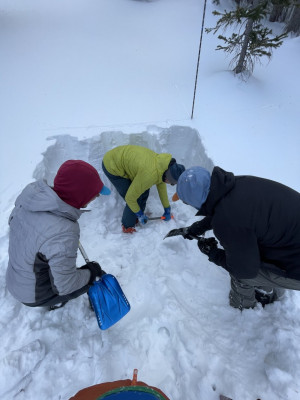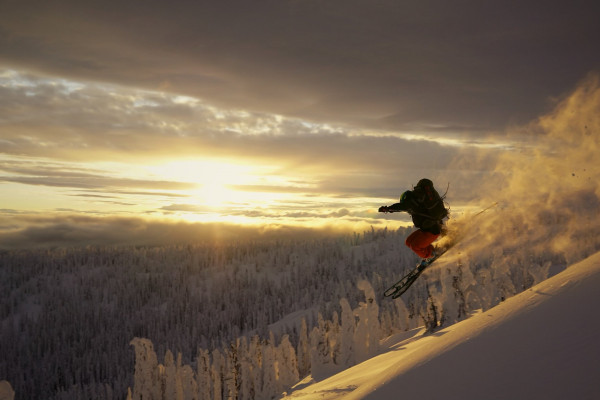12/1/2023 Red Line Traverse
By Spencer Dillon, Photos by Matt Skorina
I wish to acknowledge the Western Shoshone, Eastern Mono, Western Mono, and Northern Piute peoples, their elders past and present, their future generations, and all Indigenous peoples that have called this place home, since time immemorial. I offer gratitude for the land itself and the original caretakers of it who were forcibly removed.
Ronald Reagan was young and the President of the United States. Eye of the Tiger was inconceivably topping the charts. Skis were straight and "ski touring" meant free-heel leather boots and wool. It’s 1982 if you haven’t guessed. Allan Bard, a Sierra guide and general high-magnetism individual, Tom Carter, and Chris Cox have begun a two-year project to ski from Mt. Whitney to Mammoth to “red line the fun-o-meter.” ‘82 to ‘84 were some of the biggest boom years the Sierra ever knew: Famously deep and unrelenting. Those years shaped our collective memory of colossal Sierra storms and their future possibility. But they don’t always deliver, especially in the modern climate reality and the variability that it has introduced into the Pacific storm tracks. And most of the years since ‘the Great Bardini’ completed his Red Line traverse haven’t delivered. As my friend Stephen said of the range, “7 out of 8 times I go skiing in the Sierra, it sucks. The mountains are too big for good skiing. Big mountain wind wrecks the snow.”
The Red Line hasn’t floated at the top of American skiing consciousness for many of the years since Bard brought big, wilderness skiing to the lower 48. But Jed Porter remembered it in 2017, the last big year, skiing the highest line he could between Whitney and Mammoth in a single push. It’s Jed who I have to thank for my experience, for putting it into my brain to wait for another big year in the Range of Light. But Jed didn’t ski Bard’s line. He skied his own Red Line. Allan was famously tight-lipped about their route. Jed, to his credit, didn’t spoil the adventure for us either. Both of their trips sought to fulfill the ethos of the endeavor: Skiing the highest, cleanest line across the Sierra as one could, “stringing together dozens of exciting ski descents like so many pearls.” Jed captured his purpose similarly: “If skiing is good, more skiing is better.” So this spring, my friend Matt and I set off to see what kind of pearl necklace we could make between Lone Pine and Mammoth.
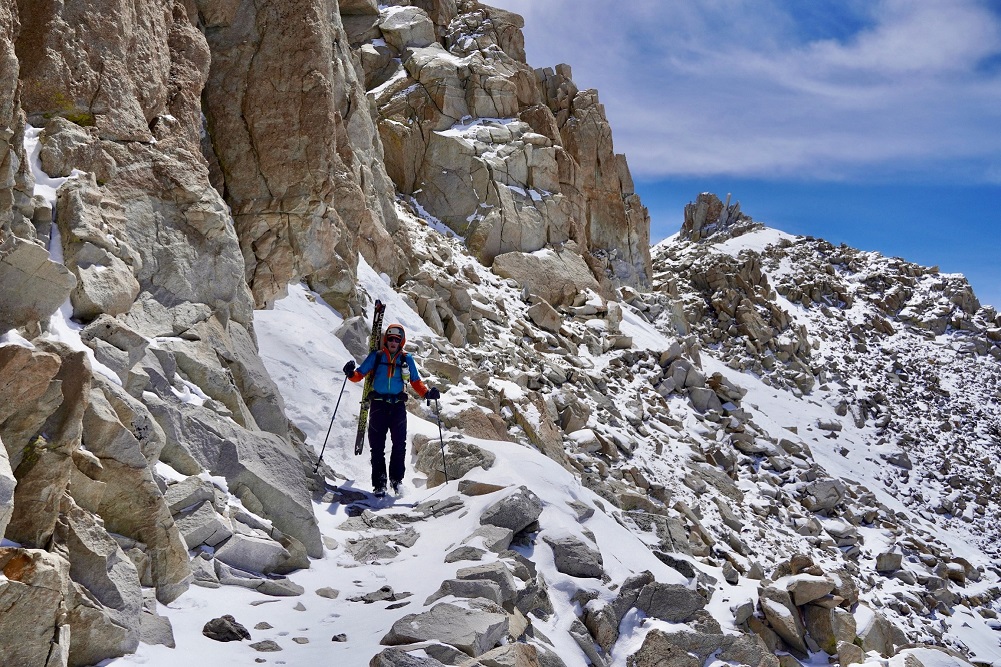
Like Jed, we wanted to stay in the hills continuously, so we arranged for friends to resupply us every week. With only a week of food at a time and no technical gear beyond crampons and axes, our packs are only modestly crushing. I skied all winter with dumbbells in my backpack to capture that over-the-handlebars feeling of crushing skimo boots while Hulk Hogan grabs you by the neck and slams your face into your frightfully close ski tips. Matt lives ~10 feet below sea level on a research vessel in the Pacific. He did not get to practice the Hulk Hogan move much this winter, but his capacity to suffer in the mountains is long-honed. At least our backpacks and boots are matching.
The forecast for the first week, when we are planning on skiing some of the biggest lines of the trip, is poor. Snowy, windy, and bitterly cold. As our departure nears, the weather flirts with improving but ultimately decides against it. So we started walking in the sand of the Alabama Hills looking up at a huge cloud cap over the southern Sierra, stretching far down into the drainages as Matt’s wife drives away. This trip is a big step up for us. Big, hard, throbbing skiing for two weeks straight. We aren’t planning on dropping below 11,000’ until we make it to the Palisades in almost 10 days. And we will be on sighting the whole thing. Those precipitous clouds scare me. Visions of my last traverse in the Wind River Range – wet, unstable skiing in a ping pong ball – float into my mind as we walk up one of the Langley drainages.
We hit snow lower than expected, though the ‘snow’ is mostly apocalyptic avalanche debris with trees 6’ across in fragments. New flakes fall from the haze above and it is cold, but we march onwards, powered by first-day enthusiasm. As we reach the high country, the coverage remains thin and we are greeted by a brisk wind. Looking out towards Whitney, I see a lot of golden Sierra granite, beautiful though threatening to our plans, at least for a while. This far south, the Sierra’s deepest winter ever still means ribbons of white cutting through endless talus. Maybe Stephen was right.
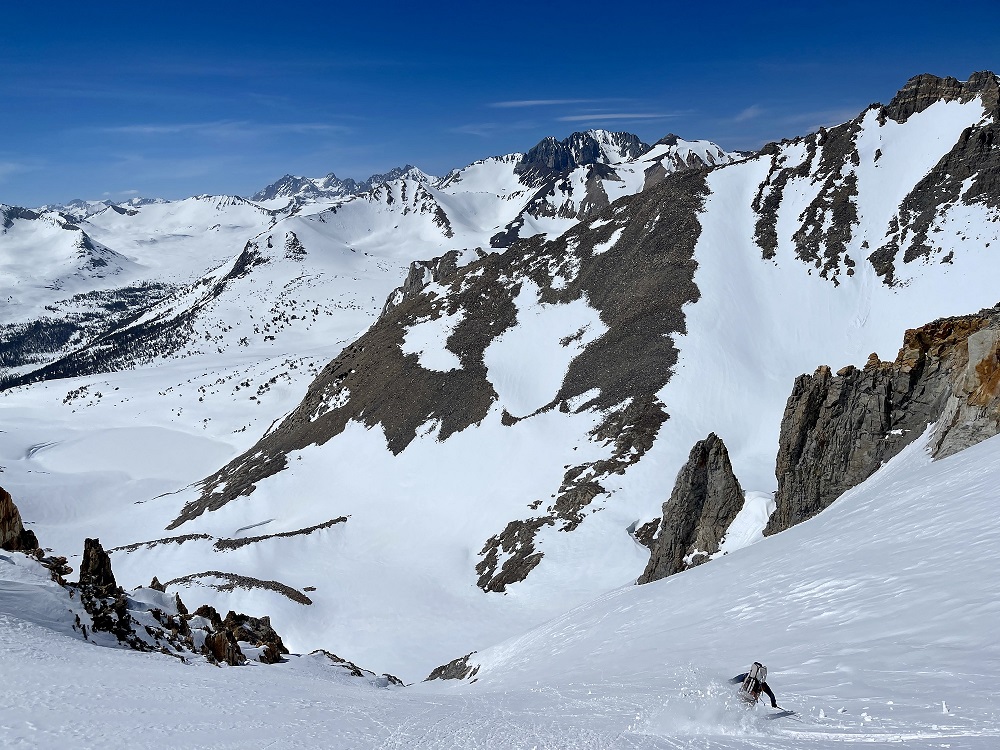
That night, we try to chip a platform in the grey ice as the wind howls in the growing dark. I snap the handle of my carbon-handled, weight weenie shovel attacking the ice. We both shiver all night wearing everything we brought. It’s hard to know how this will go. We are camped in a small, steep basin. Our morning exit looks steep and rocky, and doubt creeps in. How are we going to be walking, scrambling, and soloing between our pearls with 70-liter packs? The shadow stretches from the high, dark places into our 12,000’ basin. The cold and flurries don’t help. Lord Langley towers above is, austere and beautiful.
Days go by in a blur as we trudge. The coverage has been poor and we have been tired. We haven’t skied Whitney, Russell, or Williamson, essential pearls in Bard’s Red Line. We are focused on getting to our resupply on time, barely making turns as we traverse from pass to pass, stretching each vertical foot as far north as possible. We carry our skis over rock and dirt, walking down what we thought we would ski and tiptoeing through scree. The lines we do ski have surprising mid-pitch granite slabs dusted by fresh snow. I can’t seem to predict which features are skiable and which are terminal. I do a lot of sidestepping on those slabs as Matt skis the wiser line around me. But the Sierra is beginning to unfold to us, stretching infinitely west and north as we gain vantage after vantage. Even looking south and east among the pepper, all we can see is stone and snow for miles. Even walking by once-in-a-decade lines barely in condition fills me with incredible awe for Bard and his crew, skiing these faces decades ago.
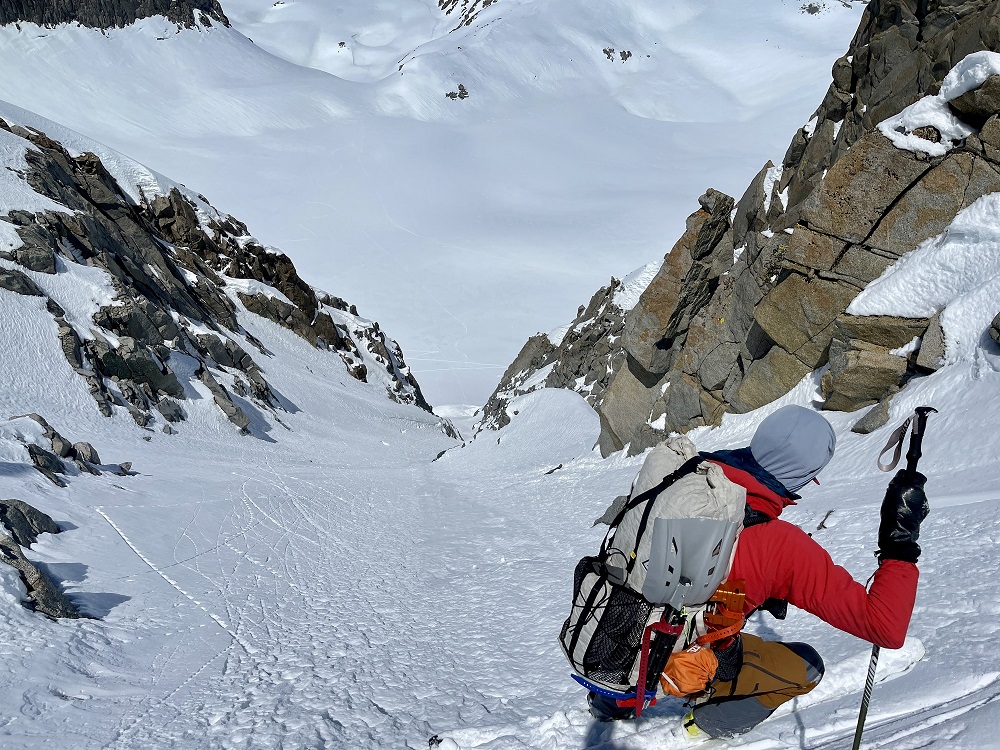
Matt doesn’t care about the concept of the Red Line. He wants to ski the logical line for our bodies and the conditions. I am kind of losing my mind. Six days in and we’ve skied no granite hallways. We’ve skied several bigger pitches, but always off a shoulder, not a summit. It doesn’t really occur to me that we are skiing just about the highest line possible with the coverage, because it’s not the Red Line. Bard skied something bigger on leathers. I keep thinking about a line we walked by that Jed described as ‘skiing a beachball.’ I hungered for it all winter, trying to prove to myself in the Wasatch that I could ski something like that while Hulk Hogan folded me over. The ‘lost opportunity’ of it drove me mad during that first week. What a stupid opinion. There wasn’t an opportunity, and it wasn’t in our Red Line.
As we near our first resupply, we find our rhythm. Matt and I have been pushing each other in the mountains for years and there is an ease in our mutual suffering. We haven’t done something quite this big before, but it doesn’t seem to throw Matt. I am engrossed by the enormity of the trip, the history, and the mountains while Matt is just out for a day of skiing. I see the magnitudes and Matt appreciates every step. He rolls his eyes and I marvel. It’s symbiotic.
Coming into our first resupply, we ski our first couloir-shaped object, a wide and steep gully off a peak with our first good supportable snow. Up to this point, it has been fluff on ice, scalloped windboard, or treacherous breakable crust. As we reach the top, weather comes in and the snow melds with the air around it, but I don’t care. I am ecstatic. The business is upon us, and our bags are light with only a few handfuls of trail mix left. The line is excellent; I ski almost 2000’ straight through, relishing the burn of turns in my quads. All I’ve felt the last week has been the scream of my right hip as I traverse heading north. But now, we are skiing! I fly down through the fog into more unpredictable snow and, like almost every day of this trip, eat shit. Matt thinks I just get too excited about the skiing and hurt myself like a dog on a mountain bike ride. I agree.
Here, the crest of the Sierra runs to the very eastern edge of the range, overlooking Independence and Highway 395. As we labor back up to the crest, the snow rolls down behind us to the tan and green of the valley. We see another skier for the first time in a week. Unimpressed by our plans, she rattles off a list of minor peaks we should be skiing further west in the great ocean of white. I can barely find any on the maps, but she really got to me. Again I feel the pangs of error in our trip. I cannot help but wonder that we are wasting our one wild and precious attempt to ski across the Sierra for the first time. When will the next boom year come?
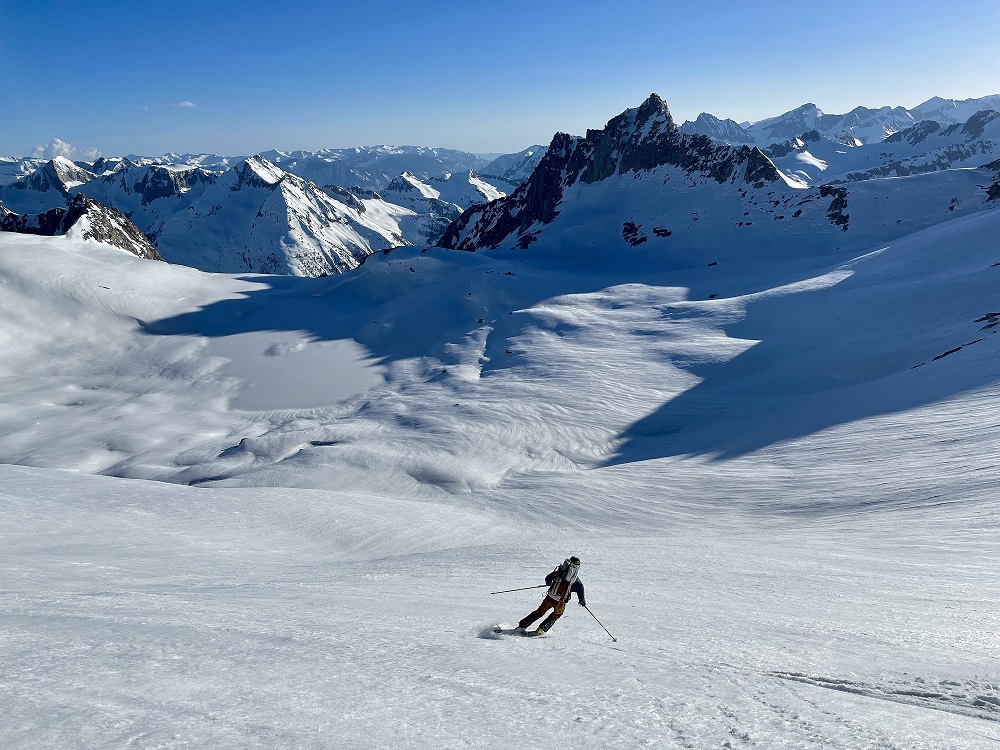
Matt is nonplussed, obviously. He reminds me that she’s wrong. We are skiing a proud line, embarked on a grand adventure. Plus, even if she was right, she’d be wrong. We don’t have to ski her line and thank god we don’t, because she was skinning straight up on her highest riser. I repeatedly bring the encounter up so that Matt can reassure me that we’re skiing our Red Line, not hers.
The same day, we begin what feels like an endless march of couloirs. The mountains have changed. No longer are we surrounded by proud spires of granite. As we ski by Split and Cardinal, there are more gullies and fewer unexpected slabs and dead ends mid-slope. We top out on ridges and look down proud lines not pictured in the guidebook, skiing as Jed did: ever onward. We walk by 50 Classics and other famous lines, wandering further west into the endless sea, but the threat of the unknown remains as it lurks behind every ridge. We make our way, our packs lightening again, legs tiring.
Soon we are in the Palisades. Big terrain and, if Stephen is to be trusted, big bergschrunds await. I spent a lot of the winter procrastinating on Google Earth, shifting through historical satellite imagery to draw a suggestion for our line. Some hidden gems were clear. Others, more unknown: a grainy thread of white up to a rock ridge and down onto a new ribbon. Thus far my optimism had found us a number of magic moments and no major skunks, but the Palisades seemed iffy, even from my computer.
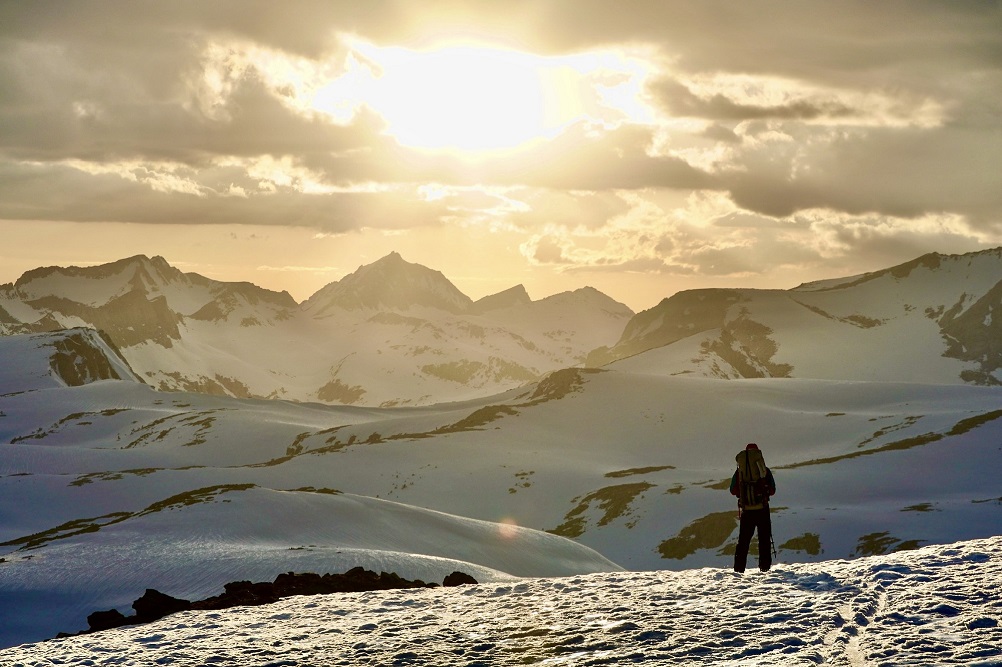
As we draw up to the west side of Norman Clyde, my fears blossom. The rock is dark, hot and dry. The ribbon I hoped to find is gone and would’ve been undoable even if the sun hadn’t gotten to it. But I want to ski V-notch so badly. A king line among royalty. But getting to it and back from the West is... complicated, even if we can follow these improbable ribbons. And our bags are getting lighter again. Our next resupply is south of Emerson, and we have a long way to go. But Matt humors me and we venture towards V-notch. There is more wind scour than we’ve seen since Whitney and doubt again blooms. Skiing it will be committing. We again scramble down what Google promised would be excellent skiing and our day stretches further into the evening, but V-notch turns out to be quite the pearl. It also reminds me that backpacks make airtime difficult.
The days continue to melt by. Things are starting to get hot and sloppy. We remember fondly the cold of our first few days, but we are growing more into our trip, skiing bigger lines better, and more sure of ourselves even as our legs and the snowpack begin to liquefy. My roommate Matthew arrives with another week of food to take us to Mammoth.
Our last week out holds the most spectacular skiing of the trip, but things become more predictable. Matthew has joined for stable weather, sloppy afternoons, hip-deep booting, and stupendous couloir after stupendous couloir. I am no longer thinking about what that woman said. We are skiing our line as we creep towards Mammoth, packs again growing lighter. Now into our third week of skiing, Matt and I exist wholly in the world of freeze-dried meals, skinning, and melting snow. The world beyond our trip feels abstract. It is impossible to imagine a time out of boots, future or past.
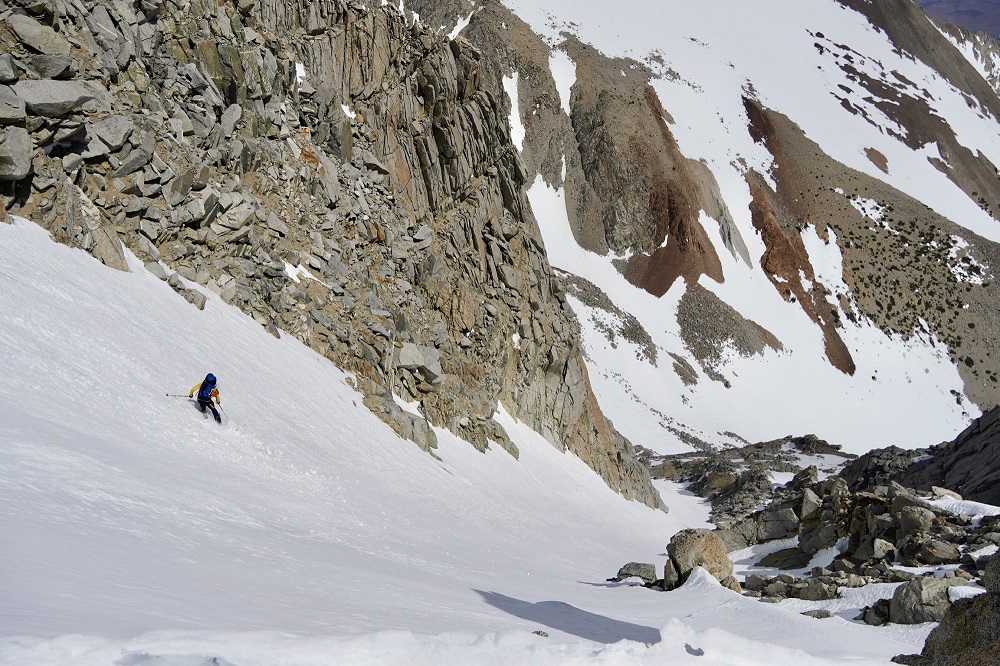
I had packed food for another week of skiing north to Bridgeport. It is waiting for us in Mammoth, but Matt and Matthew are going to tap out, having skied ‘the Red Line’ or something like it. I hope to continue. Since I had conceived of going further, finishing in Mammoth feels incomplete. But so would a week without my friends, soldiering on through thunderstorms and scorching heat by my lonesome. I am also tired. Is another week of skiing better than not? Was the point not to have as much fun as possible between Whitney and Mammoth? Would it be fun? This hemming and hawing continues for several days.
I take maybe my biggest fall of the trip on a small pitch between Red Slate and Bloody Mountain after a toepiece rips. It’s a strange feeling to see your toepiece on your boot as your ski slides away. I had been supergluing it every other day as each screw in turn spun freer. But it would be voile straps from now on.
Booting up the backside of the Bloody, it feels like my decision has been made. This will be my last pearl, and suddenly the future rushes in. Before I can blink I am in town and have skied my Red Line. Next time I think my Red Line will go to Bridgeport.
Comments
